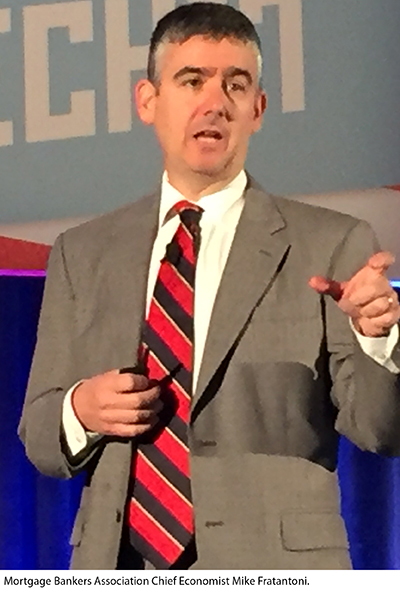
MBA: Strong Economy, Job Growth Spurs Stronger Purchase Market
CHICAGO–Mortgage Bankers Association Chief Economist Mike Fratantoni expressed optimism on prospects for the home purchase market this year, citing strong job numbers and firm economic growth. But he cautioned that costs to originate loans could put a damper on the real estate finance industry.
“The broader economy looks really good,” Fratantoni said here at the MBA National Technology in Mortgage Banking Conference & Expo, noting the MBA forecast calls for 2 percent growth over the next two years. “Not great, but solid,” he said.
Fratantoni said continued job growth and economic strength will likely spur the Federal Reserve to continue to raise the federal funds rate, which he noted will have an upward impact on mortgage rates–and subsequently, a drop in demand for refinance applications.
 “On the other hand, rising interest rates will also spur an increase in purchase applications, as consumers try to lock in a lower rate,” Fratantoni said. “It won’t make up for the entire drop in refinances, but it will have some impact.” The MBA forecast calls for total mortgage originations of $1.9 trillion in 2016.
“On the other hand, rising interest rates will also spur an increase in purchase applications, as consumers try to lock in a lower rate,” Fratantoni said. “It won’t make up for the entire drop in refinances, but it will have some impact.” The MBA forecast calls for total mortgage originations of $1.9 trillion in 2016.
Wage growth has also accelerated, Fratantoni said. “Given the incredible drop in unemployment claims and the continued demand for jobs, we expect wage growth to continue to grow,” he said. Higher wages often translates into higher inflation, Fratantoni added, which will likely prompt the Federal Reserve to increase the federal funds rate three, and possibly four times this year.
The MBA forecast calls for short-term rates to accelerate quickly, with slower long-term growth. MBA expects mortgage rates to be above 5 percent by 2018, Fratantoni said.
For housing, MBA says as Millennials continue to move into adulthood, both the rental and housing markets show “extraordinarily favorable” trends. “Demographics are favorable; job growth is favorable,” he said.
And yet, Fratantoni noted the home purchase market has still not truly taken off. He cited higher demand as a result of increasing rates; and low housing inventory, which is hampering first-time buyers and move-up buyers.
“A lot of first-time buyers are still taking a wait-and-see attitude because of rates,” Fratantoni said. “But despite a ramp-up on the part of home builders, we’re just not seeing the inventory that’s needed to sustain the market. Inventory is low everywhere, which suggests the home purchase market forecast could be a bit aggressive.”
Mortgage delinquency and foreclosure rates continue to moderate as loan quality improves, Fratantoni said, despite a recent uptick reported in the MBA 4th Quarter National Delinquency Survey. “Delinquency rates tend to track with unemployment rates,” he said. “If we’re near full employment, then it stands to reason that delinquency rates could level out as well.”
Question marks persist, however, Fratantoni cautioned, noting the cost of mortgages and the drop in production volume for banks as the share of non-bank origination and servicing continues to increase. He said more and more lenders are retaining their servicing. “We’re going into a tougher space, regardless of what type of institution you are,” he said. “This is especially true for retail banks, which enjoyed the refinance boom, but must now adjust to a purchase market.”
Fratanoni said the industry requires continued investment in technology to increase efficiencies and control costs. “Technology as a total share of expenses is expected to increase,” he said. “There’s going to be an interesting tension across the industry, as companies decide where to allocate their resources.”
“The rising costs and diminishing profit margins of both the purchase and servicing businesses are examples of how technology can be brought to bear,” Fratantoni said.
